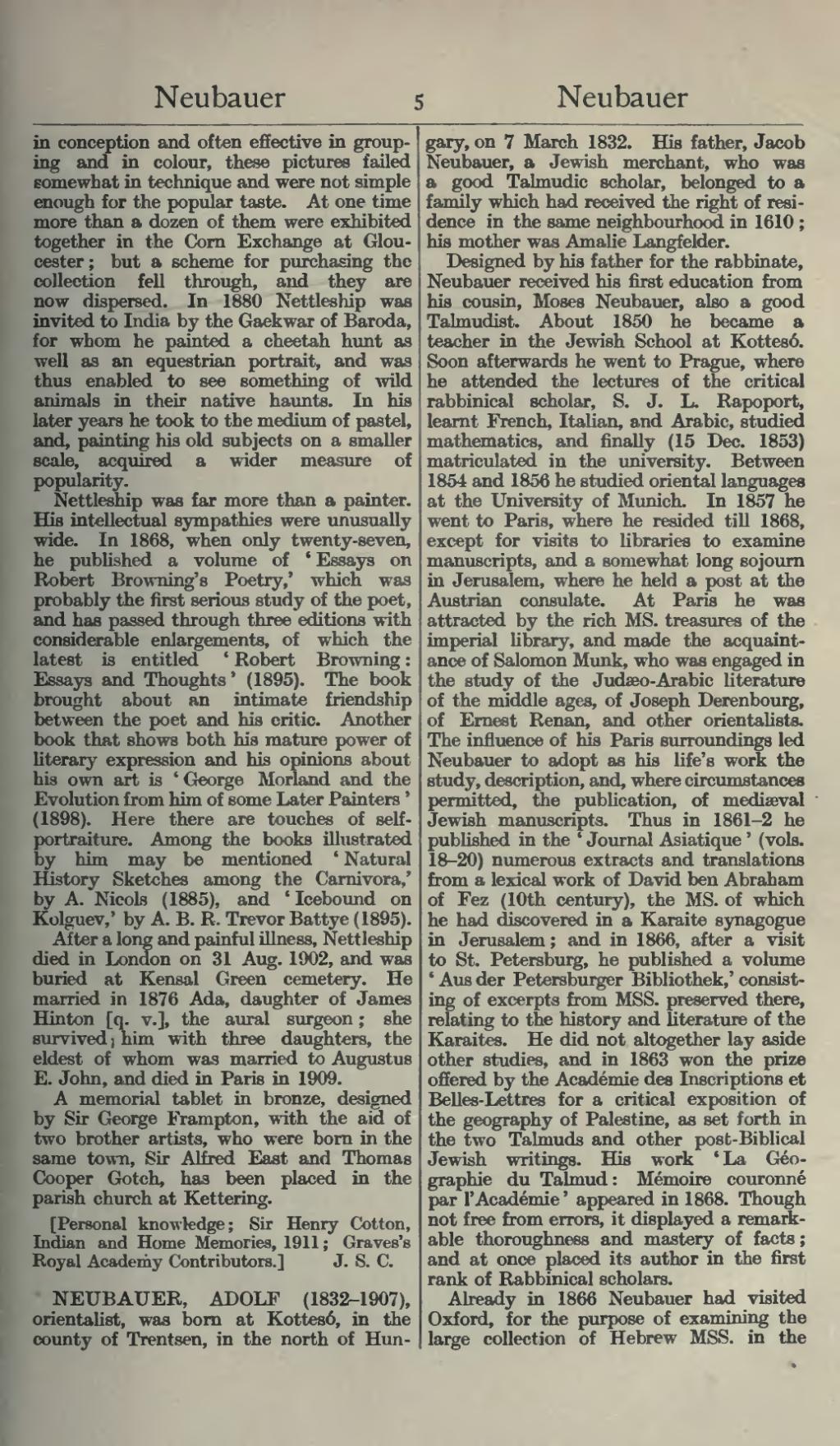in conception and often effective in grouping and in colour, these pictures failed somewhat in technique and were not simple enough for the popular taste. At one time more than a dozen of them were exhibited together in the Corn Exchange at Gloucester; but a scheme for purchasing the collection fell through, and they are now dispersed. In 1880 Nettleship was invited to India by the Gaekwar of Baroda, for whom he painted a cheetah hunt as well as an equestrian portrait, and was thus enabled to see something of wild animals in their native haunts. In his later years he took to the medium of pastel, and, painting his old subjects on a smaller scale, acquired a wider measure of popularity.
Nettleship was far more than a painter. His intellectual sympathies were unusually wide. In 1868, when only twenty-seven, he published a volume of 'Essays on Robert Browning's Poetry,' which was probably the first serious study of the poet, and has passed through three editions with considerable enlargements, of which the latest is entitled 'Robert Browning: Essays and Thoughts' (1895). The book brought about an intimate friendship between the poet and his critic. Another book that shows both his mature power of literary expression and his opinions about his own art is 'George Morland and the Evolution from him of some Later Painters' (1898). Here there are touches of self-portraiture. Among the books illustrated by him may be mentioned 'Natural History Sketches among the Carnivora,' by A. Nicols (1885), and 'Icebound on Kolguev,' by A. B. R. Trevor Battye (1895).
Aiter a long and painful illness, Nettleship died in London on 31 Aug. 1902, and was buried at Kensal Green cemetery. He married in 1876 Ada, daughter of James Hinton [q. v.], the aural surgeon; she survived; him with three daughters, the eldest of whom was married to Augustus E. John, and died in Paris in 1909.
A memorial tablet in bronze, designed by Sir George Frampton, with the aid of two brother artists, who were born in the same town. Sir Alfred East and Thomas Cooper Gotch, has been placed in the parish church at Kettering.
[Personal knowledge; Sir Henry Cotton, Indian and Home Memories, 1911; Graves's Royal Academy Contributors.]
NEUBAUER, ADOLF (1832–1907), orientalist, was born at Kottesó, in the county of Trentsen, in the north of Hungary, on 7 March 1832. His father, Jacob Neubauer, a Jewish merchant, who was a good Talmudic scholar, belonged to a family which had received the right of residence in the same neighbourhood in 1610; his mother was Amalie Langfelder.
Designed by his father for the rabbinate, Neubauer received his first education from his cousin, Moses Neubauer, also a good Talmudist. About 1850 he became a teacher in the Jewish School at Kottesó. Soon afterwards he went to Prague, where he attended the lectures of the critical rabbinical scholar, S. J. L. Rapoport, learnt French, Italian, and Arabic, studied mathematics, and finally (15 Dec. 1853) matriculated in the university. Between 1854 and 1856 he studied oriental languages at the University of Munich. In 1857 he went to Paris, where he resided till 1868, except for visits to libraries to examine manuscripts, and a somewhat long sojourn in Jerusalem, where he held a post at the Austrian consulate. At Paris he was attracted by the rich MS. treasures of the imperial library, and made the acquaintance of Salomon Munk, who was engaged in the study of the Judæo-Arabic literature of the middle ages, of Joseph Derenbourg, of Ernest Renan, and other orientalists. The influence of his Paris surroundings led Neubauer to adopt as his life's work the study, description, and, where circumstances permitted, the publication, of mediæval Jewish manuscripts. Thus in 1861–2 he published in the 'Journal Asiatique' (vols. 18-20) numerous extracts and translations from a lexical work of David ben Abraham of Fez (10th century), the MS. of which he had discovered in a Karaite synagogue in Jerusalem; and in 1866, after a visit to St. Petersburg, he published a volume 'Aus der Petersburger Bibliothek,' consisting of excerpts from MSS. preserved there, relating to the history and literature of the Karaites. He did not altogether lay aside other studies, and in 1863 won the prize offered by the Académie des Inscriptions et Belles-Lettres for a critical exposition of the geography of Palestine, as set forth in the two Talmuds and other post-Biblical Jewish writings. His work 'La Géographie du Talmud: Mémoire couronné par l'Académie' appeared in 1868. Though not free from errors, it displayed a remarkable thoroughness and mastery of facts; and at once placed its author in the first rank of Rabbinical scholars.
Already in 1866 Neubauer had visited Oxford, for the purpose of examining the large collection of Hebrew MSS. in the
